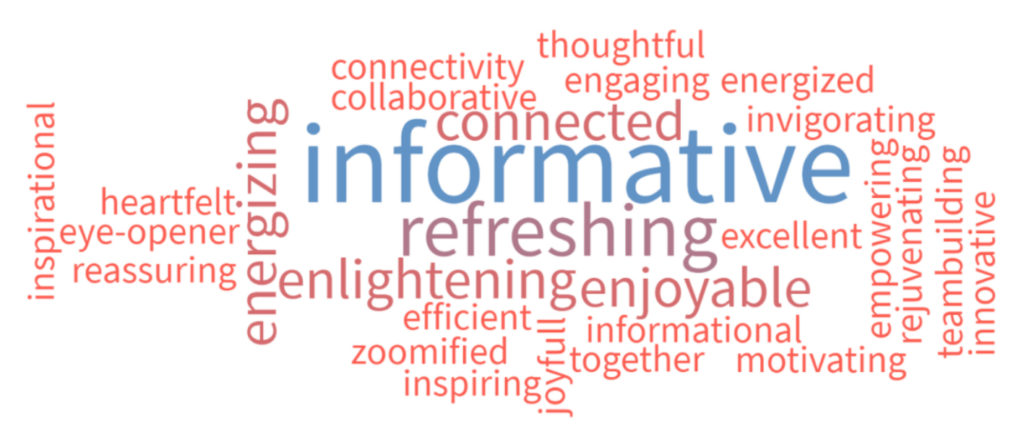When “all hands” can’t be in the same room: planning engaging virtual all-staff retreats
Beyond providing space for everything ranging from blue sky thinking to brass tacks planning, staff retreats (often referred to as “all hands” meetings) can serve as an opportunity for culture building by bringing the entire team together in the same room.

As a consequence of COVID-19, most organizations initially choosing to hold in-person staff retreats must now do them virtually (or not at all) since travel and meeting options are limited. For Common Threads, the pandemic eliminated the ability for our team of nearly 40 people who live in more than a dozen markets to come together in one physical location. This was definitely a downer for our organization, which enjoyed bringing everyone together for an all-hands meeting in Austin last July.
To be fair, our team had a leg up since we were already accustomed to the realities of virtual meetings via videoconferencing before COVID-19 (and I’m proud to say we’ve become pretty good at it). Despite this, I expected that our employee engagement and overall productivity at the retreat would take a precipitous drop as a result of being in a virtual environment.
Thankfully, I was wrong. The mood on all three days of our recent retreat felt really upbeat, with many staff expressing how refreshing the format was, how well connected they felt to fellow staff, and how much they felt they absorbed the content we shared. In a follow-up survey, all 33 of our staff who responded to the survey rated the virtual retreat as “Excellent” or “Good.” At the end of the last day, staff shared one word that came to mind, with “energizing,” “engaging,” “informative,” “refreshing,” and “enlightening” shared frequently.

While many staff would have preferred an in person meeting, it was fulfilling to see that our fundamental objectives were met despite having to meet virtually.
How did we do it? Following are a few ways Common Threads was able to move its retreat from in-person to virtual without sacrificing staff engagement and productivity.
1) Set an overarching goal and stick with it. Not surprisingly, the themes of innovation and change bubbled up given how much COVID-19 and conversations on social justice were impacting the communities Common Threads reaches. Sessions on diversity, equity & inclusion, creative fundraising strategies and innovative educational partnerships supported the intended outcome of helping Common Threads better understand how it could best fulfill its mission in the upcoming (and uncertain) academic and fiscal year.
2) Set the agenda to match the environment. In-person retreats tend to be filled with full days so staff can maximize their time together, especially when an organization invests in hotel and airfare expenses to make this happen. A virtual environment removes this pressure. Given the pressures of COVID-19, staff wellness and work-life balance were key considerations. Common Threads’ leadership team made an early commitment to schedule only about three hours of content each day (with dedicated breaks), which is about half of what was planned in 2019. Keeping the days short not only minimizes Zoom fatigue, but it also helps staff with kids consolidate any child care needs, allowing them to more easily focus on the retreat.
3) Plan, plan, and then review your plan. One of the reasons staff often dislike staff retreats is because they’re not planned or organized as much as they should be. The reality is that the best staff retreats require the same care as events that reach external stakeholders. Assemble a team of staff volunteers to plan and execute each area of the retreat, and give them the dedicated time to do it so it doesn’t feel like an additional burden. Many hands make for lighter work (and a more engaged team) so put out a call for staff to help you with specific duties such as timekeepers, speaker hosts, notetakers, icebreaker leads, and more.
4) Virtual environments foster participation. One of the silver linings of holding your staff retreat virtually is that you can very easily include attendees who might not otherwise be able to join you due to travel costs and scheduling conflicts. Common Threads reaped this benefit with our three external speakers, two contractors and six interns who likely would not have been able to join an in-person retreat.
5) Ignite the excitement. A few days before the retreat, Common Threads mailed each staff member a themed “Box of Sunshine” that was used to deliver a newly designed T-shirt with a few snacks and fun items. A colorful flyer described each item with a compliment about the team (i.e., “Wheat Thins Chips were included because we think you’re ‘all that and a bag of chips’”).

6) Open with energy. We intentionally started the first 15 minutes of the day with an icebreaker, a carryover from our in-person retreats. On the first day, singer/songwriter Daryn Alexus sang Estelle’s “American Boy” and Stevie Wonder’s “I Wish” (songs whose lyrics took on new meaning during quarantine). To open up day 2, a staff member led an at-home scavenger hunt, asking staff to find and bring back obscure household items such as CDs, house plants and masks, each within 20 seconds. Austin-based wellness expert Liz Davis helped us wind down the retreat with a short yoga and mindfulness exercise on the last day.
7) Make sure your staff doesn’t get “hangry.” As a nonprofit that teaches children and families about cooking and nutrition, food is always top of mind at Common Threads. We love to teach others about food as much as we love to eat it! Since we couldn’t cater team lunches in a virtual environment, we created an easy but cost-effective alternative. Each employee received a $20 grocery stipend and we encouraged them to make one or more recipes from our Common Bytes nutrition resource hub. This activity fulfilled three important objectives: it fed our staff, it created a block in the agenda for social time, and it gave staff a reason to explore our curriculum.
8) Embed interaction when you can. Most videoconferencing software allows you to set up breakout rooms for group discussions, which is a nice way for staff to connect and stay engaged. We employed this a few times, including creating virtual “lunch tables” where five or six randomly assigned staff would eat lunch together while discussing fun icebreaker questions. In another session, we broke staff out by market and engaged them in a brainstorming exercise on how each market could innovate in the age of COVID-19. Moving away from a single “talking head” lecture format tends to keep staff more engaged.
9) Passive programming makes breaks fun. With a compressed agenda, we didn’t have a lot of agenda time for some of the fun elements, so we decided to provide passive “commercial break” content during our 15 minute breaks. Staff had a chance to hear from some of our board members in 60 second pre-recorded video greetings that were played at the beginning of each break. Additionally, looped presentations with staff photos and kudos messages were shown, with staff members’ favorite songs played from our YouTube playlist.
10) Seek feedback. In this year’s closing session our leadership team members led a “pulse check” discussion, encouraging staff in their breakout groups to share thoughts on how the organization could navigate COVID-19 and build on the momentum started during the retreat. A more formal survey was shared a few days after the retreat to encourage deeper reflection and analysis. This step should not be overlooked. You’ll likely see some surprising themes in the results that will help you shape future staff meetings, including your larger retreats.
Although COVID-19 has placed constraints on the ways organizations can host its staff retreats, with a little planning and the help of technology, employees and leaders can still have a fulfilling experience when these important events are held virtually. It’s important to keep these traditions going, now more than ever. Good luck!
ABOUT COMMON THREADS
Common Threads is a national nonprofit that provides children and families cooking and nutrition education to encourage healthy habits that contribute to wellness. We equip under-resourced communities with information to make affordable, nutritious and appealing food choices wherever they live, work, learn and play. We know that food is rooted in culture and tradition, so we promote diversity in our lessons and recipes, encouraging our participants to celebrate the world around them. To learn more, visit www.commonthreads.org or on social media by searching for #CookingForLife.